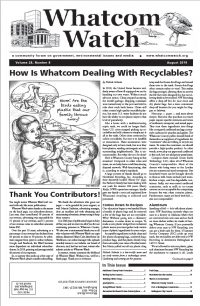by Betsy Gross
Buildings Work Group
Architecture 2030’s Erin McDade was the first of three presenters for the Buildings Work Group at the June 5 Bellingham Climate Action Task Force meeting. She provided a comprehensive analysis of Bellingham’s current building stock, and made specific recommendations on what needs to be done to drastically reduce carbon emissions stemming from buildings.
What is Architecture 2030, I wondered? I Googled it and learned that they provide leadership and “… design high-impact actions needed to achieve a carbon-neutral built environment by 2050.” Their stated mission is to “… rapidly transform the built environment from the major contributor of greenhouse gas emissions to a central solution to the climate crisis.”
Architecture 2030 has completed a comprehensive analysis of all the buildings in 13 cities in North America, and Bellingham is one of them. To learn more about Architecture 2030, visit: https://architecture2030.org/. They have issued a worldwide 2030 Challenge, asking the global architecture and construction worlds to adopt greenhouse gas reduction targets for new and renovated buildings.
Ms. McDade began by relating the Buildings Work Group spent many hours meeting with multiple local building experts and that their opinions also inform this group’s presentation and recommendations.
New buildings are not our main challenge, as updated building codes address much of what needs to be done to construct low-carbon buildings. It is the current building stock, especially our older buildings, which presents the primary challenge to reducing carbon emissions from buildings. And, fully 43 percent of the city’s greenhouse gas (GHG) emissions come from buildings — even more than emissions from the transportation sector!
Here are a few more statistics to give you a fuller perspective of the enormity of our task ahead:
• When organized by type, 48 percent of Bellingham’s building stock consists of single-family dwellings, 24 percent multifamily, and 28 percent commercial buildings.
• When you organize buildings by size, you see that most of them are under 10,000 square feet: 24,000 or 94 percent of our city’s buildings. One thousand, five hundred buildings, or 6 percent, are over 10,000 square feet. Ms. McDade stressed that size matters: if we do nothing to bring down our buildings’ carbon emissions, by the year 2035 these 1,500 large buildings will emit 42 percent of our city’s building GHGs. Getting them to carbon zero is a big deal.
Ms. McDade presented her work group’s building decarbonization proposals, according to building size and type: big buildings, small buildings/renter-occupied, small buildings/owner-occupied, and new buildings. I detail their proposals for each building size and type for you below.
Big Buildings
Big buildings, again, are defined as being over 10,000 square feet. In Bellingham, 17 percent of the buildings this size and above are multifamily dwelling units such as apartments and condos, and the remaining big buildings are commercial. Typically, these big buildings have long-term, planned capital improvement budgets and cycles around which anticipated energy upgrades can be targeted. Owners of these types of buildings can therefore integrate retrofits and upgrades into these cycles. It is recommended they select one of two different pathways to decarbonize them.
• All buildings larger than 10,000 square feet are to electrify space and water heating systems by 2035 and install solar panels on at least 50 percent of these buildings’ roof space. or
• All big buildings are to use the following timeline to reduce their GHG emissions: 35 percent reduction by 2025, 65 percent by 2030, and 100 percent by 2035. The city should support these upgrades with implementation toolkits and financing incentives; while they represent a small percent of the city’s buildings, they emit a large percent of the building sector’s GHGs.
Small Buildings — Renter-Occupied
Currently 72 percent of buildings that fit this description are multifamily-occupied, while the remaining 18 percent are rented by single families. Rental buildings have planned cycles of rental inspection and license renewal, which Ms. McDade recommended be utilized for compliance inspections via the city’s Rental Registration and Safety Inspection Program. This segment of the building sector should be heavily subsidized to avoid passing energy upgrade costs to renters, especially for low- and moderate-income housing. The retrofit/upgrade recommendations for these types of buildings are the same as for big buildings discussed above.
New Buildings
The state has adopted very aggressive building codes for new construction. The first and simplest recommendation, therefore, is that the city adopt the state’s building code efficiency standards and then require that all new construction meet those standards. Ms. McDade also recommended the installation of solar PVs or capacity to purchase community solar, and fully electric space and water heating systems, all be required.
Small Buildings That Are Owner-Occupied
Small buildings that are owner-occupied represent the largest percentage of buildings in Bellingham — over 20,000 of them. Think single-family home, which represents 82 percent of this group of buildings. The other 28 percent are multifamily buildings. Retrofitting these will constitute our biggest lift.
How will we decarbonize 20,000-plus buildings in 15 years with the least economic and social impact?
Let’s start with the building work group’s decarbonization proposals, the “what needs to be done” part:
• When ownership changes hands, ensure the building meets specified efficiency thresholds within one year of purchase. It is recommended these upgrades will be paid for by the buyer, not the seller.
• What is meant by “efficiency thresholds?” This is still a work in progress; it depends on the age of the building. Proposed upgrades include installing solar panels equivalent to at least 50 percent of the building’s footprint or buying into PSE’s Green Direct program within one year of purchase; electrifying space and water heating systems within two years of purchase.
Now, for the “how to pay for it” part. Most of you are wondering how on earth you can afford these upgrades. Ms. McDade acknowledged this huge goal isn’t possible without ample financial support. Included in their recommendations, therefore, is that all upgrade costs be wrapped into mortgage financing or on-bill financing, to eliminate upfront costs. It would most likely add less than $100/month to the mortgage, and, additionally, result in significantly reduced household energy costs. There are other financial options. I provide a sampling of what was covered below.
Retrofitting our current building stock is going to cost big money. Folding these upgrades into mortgages at the point of sale is one great option, but it won’t begin to cover the myriad costs of this huge undertaking for all these types of buildings. This topic was addressed by the Buildings Work Group’s second speaker, Mark Gardner, Bellingham’s Legislative Policy Analyst. Mr. Gardner made several proposals describing the many financial resources that are either already available or recommended to be developed, to enable us to make these changes.
First, he reviewed the city’s stated goals, the first being to “… support residents and commercial customers with assistance to help them with energy upgrades regardless of the complexity of their project.” Among the cluster of recommendations to meet this goal are to consider hiring a Green Building specialist, to provide technical assistance on financing options to ensure cost is not a barrier, to refer more complex projects to the Opportunity Council’s Community Energy Challenge, and to consider subsidizing design work to reduce project costs.
Mr. Gardner proposed the city’s second overall goal is “… to create a Bellingham Clean Energy Fund to catalyze substantial and rapid investments, capitalized with funds from a variety of possible sources …” such as the Washington State Department of Commerce’s Clean Energy Fund, REET (Real Estate Excise Tax), and several others.
If it turns out a tax is needed, he proposed it be a gas utility tax with lower income households exempted. Mr. Gardner touched on a multitude of financing mechanisms that are already available, such as the Fannie Mae Green Financing Loan Program. These many established programs represent hundreds of millions of dollars getting pushed out the door that don’t require a penny out of the city.
He also described some potential uses of the proposed Bellingham Clean Energy Fund. This fund could be tapped to provide incentives for major projects, especially if they’re for low- and moderate-income housing. They could also be used to create a community revolving loan fund to support energy upgrade projects, with loan recipients being allowed to pay back into the fund over time. Money from this fund could be used to support residential and/or community solar projects.
The third speaker and Buildings Work Group member was Mark Schofield, Manager, Opportunity Council’s Community Energy Challenge. He presented on the equity and social justice principles this work group used to undergird all their proposals. These principles include fully acknowledging the cost of this endeavor, which means being responsible for ensuring low- and moderate-income households are not unduly burdened and providing adequate incentives/subsidies/exemptions as appropriate/needed.
He recommended that the city commit to the need to communicate to the community the requirements/pathways for all these changes, their timelines for implementation, and the available resources. The city believes it should not be hard to get help figuring out what to do, how to do it, and what the benefits are to electrification, both to us as individuals and to the entire community. For example, some side benefits of reduced fossil fuel energy include improved indoor air quality and health, local job creation in energy efficiency and renewable energy sectors, and more. For we are all in this together, folks.
There is a lot to accomplish, but there are lots of resources out there and the city commits to helping us. For more information, this video covers the entire meeting: https://www.youtube.com/watch?v=5CI20NWwCK0.
__________________________________
Betsy Gross is a retired mental health professional. In 2003, she retired from the County of San Diego and moved to Bellingham with her family. She is a grandmother, outdoor enthusiast, and political activist. She has devoted her time to several local causes over the years, primarily to environmental activism.





























